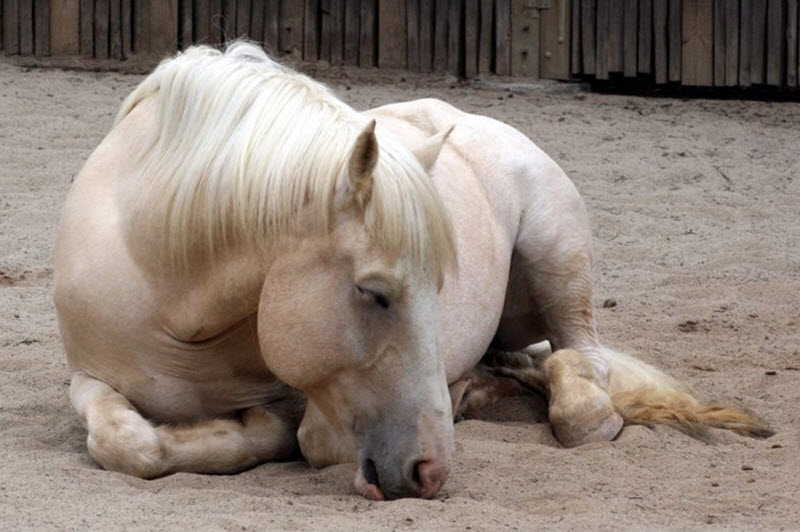Contents
This draft horse breed was developed in the United States in the early 20th century, when horse and carriage was still a common mode of transportation. The American Cream Draft (ACD) horse is a medium-heavy horse known for its sure-footedness and easy movements. It is distinguished by its creamy colour – formally known as gold champagne – and mesmerizing amber eyes.
Today, the ACD is a rare breed, as the need for draft horses dropped dramatically in the United States after WWII. Some of the most well-known remaining ACD horses are the ones that live and work at the living-history museum Colonial Williamsburg in Virginia, USA.

Old Granny
All American Cream Draft horses can trace their lineage back to the foundation mare Old Granny. She was a cream-colour mare with pink skin and amber eyes. Exactly when she was born remains unknown, but it was in the early years of the 20th century (probably between 1900 and 1905). In 1911, she was put up for auction in Story County, Iowa, and bought by the stock dealer Harry Lakin. She was subsequently purchased by the Nelson Brothers Farm and went to live in Jewell, Iowa.
Old Granny gave birth to many foals and quite a few of them had the same cream-colour as her. These cream-coloured horses were considered very beautiful and buyers were willing to pay extra for them.
In the mid-1930s, some breeders started to linebreed and inbreed the cream-coloured horses to fix their coat colour, eye colour and certain other characteristics. One of these breeders were C.T. Rierson who owned several cream-coloured mares sired by Silver Lace No. 9. Silver Lace No. 9 was a great-great-grandson of the stallion Nelson´s Buck No. 2, who was foaled by Old Granny back in 1920.
The genetics behind the “gold champagne” look
The gold champagne look of the American Cream Draft is produced by the actions of the champagne gene upon a chestnut base colour.
How large is an American Cream Draft (ACD) horse?
The mares are 15-16 hands and typically weigh around 1500-1600 lbs, while stallions and geldings are 16-16.3 hands and weigh at least 1800 lbs.
Body type
The ideal head and body type for an ACD horse:
- A refined head with a flat facial profile.
- Sloping shoulders, wide chest and well-sprung ribs
- A short and strong back
- Well-muscled hindquarters
- Strong legs that are set well apart
- Strong hooves
Colour etc
The ideal American Cream Draft horse features a medium cream coat (produced by the champagne gene), pink skin, white mane and tail, and amber-coloured eyes.
Even though medium cream is ideal, horses that sport any other cream colour can register as well, provided that they fulfil the other requirements. This means that the breed registry is open not just for medium cream but also for light cream and dark cream. Also, hazel-coloured eyes are acceptable.
Dark-skinned horses and light manes and tails
A dark-skinned mare may be accepted by the breed registry if she fulfils the other requirements, and the same is true for a mare that has a light mane and tail (instead of white). For stallions, there are no such exceptions – the skin must be pink and the mane and tail must be white.
The Appendix Registry
- A foal (from two registered ACD parents) that is too dark for the main breed registry may be registered in the Appendix Registry.
- If certain conditions are fulfilled, a foal with only one registered ACD parent may be registered in the Appendix Registry. The non-ACD parent must be a draft horse.
The horses registered in the Appendix Registry is an important asset to the breed, since they can be used to diversify the bloodlines and prevent problems associated with inbreeding.
Temperament
The ACD horse is a very calm horse that is eager to please.
Junctional epidermolysis bullosa
Compared to non-draft horses, the American Cream Draft has an elevated risk of getting a genetic disease called junctional epidermolysis bullosa. This disease is not unique to the ACD; it is an autosomal recessive genetic disease that several draft horse breeds have an increase risk of getting.
Junctional epidermolysis bullosa is the cause of the health conditions that veterinarians colloquially call red foot disease and hairless foal syndrome.
The American Cream Draft Association
The American Cream Draft Association created the breed standard for ACD in Iowa, USA in 1944. The association had been founded by 20 owners of cream-coloured draft horses. Two years later, 98% of the horses registered with the association could trace their lineage back to Old Granny.
In 1950, the Iowa Department of Agriculture recognized the American Cream Draft as a separate horse breed. Before the decade was over, however, the number of living ACD horses in the registry had dwindled down to just 200 individuals, as the need for draft horses in the United States had dropped dramatically.
Eventually, the ACD registry became inactive and remained dormant until 1982 when it was revived by three dedicated families.
Silver Lace No. 9 and Ead´s Captain
Two examples of stallions that have had a very large impact on the ACD breed are Silver Lace No. 9 and Ead´s Captain.
Silver Lace No. 9, born in 1931 out of a light chestnut Belgian mare, was a great-great-grandson of Nelson´s Buck No. 2, a stallion foaled by Old Granny in 1920. Silver Lace No. 9 was a very heavy stallion who weighed 2,230 lbs. It is believed that his heaviness was inherited from this Belgian mother. Silver was never entered into any breed registry, but he was a very popular stud in Iowa and sired a large number of foals.
Just like Silver Lace No. 9, Ead´s Captain had a major impact on the ACD breed. Nowadays, roughly one-third of all the registered ACD horses can trace their ancestry back to Ead´s Captain.
